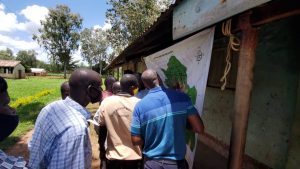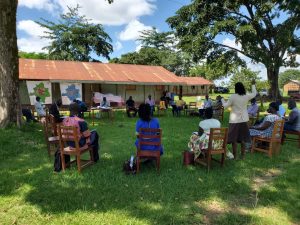The Global Green Growth Institute (GGGI) with support from the European Union has since July 2020 been implementing a three-year project; “Greening Uganda’s Urbanization and Industrialization”. For the past 12 months, GGGI has been supporting the preparation of new city Physical Development Plans (PDPs) in Arua and Gulu and Infrastructure and Investment plans there and in Jinja and Mbarara. Bankable projects to enable them to tackle their development challenges are to be the result.

Picture 1: Local leaders from Arua reviewing physical development map.
This support is directly linked with the implementation of the the Third National Development Plan (NDP III) as well as the implementation of the National Urban Policy and National Physical Planning laws in Uganda.
The support further helps the implementation of Uganda Green Growth Development Strategy (UGGDS) 2017/18 – 2030/31. This proposes comprehensive physical and development planning of Uganda’s secondary cities and the attraction of sustained infrastructure investments. This is to turn the new city councils into engines of economic growth and loci for minimizing environmental impact.
The green growth aligned PDPs for Arua city covers 401 km2 whereas and Gulu city covers 242.5Km2. Both plans cover the old municipal boundaries and their new annexed areas. GGGI is working with Mbarara and Jinja cities as well to develop the Infrastructure Investment plans which will help to determine the implementation of the PDPs. The Institute is undertaking resource mobilization for implementation through designing at least four projects for each of the cities. These projects will directly address the most pressing infrastructure deficit of the cities as well as the areas with the greatest green growth impact.
The PDPs articulate the city high-level land use, form, and determine the desired city growth pattern. They identify spaces and allotments for various land use activities and services in the city regions. Some of the key land uses include, housing, industry, commerce, green open spaces, agriculture while services include energy, transport, education, health, waste (solid and liquid), water, communications among others. The plans determine ways and mechanisms for creating jobs and incomes for women and youths. They also involve all stakeholders in the development process as well as actions to reduce environmental impact and pollution, thus attaining a green growth transition.
The plans also determine ways of developing the infrastructure as well as covering the gaps leading up to the desired goals. The plans cover the period until 2040. A development progress/impact monitoring mechanism called the City Urban Development Score Card has been developed to help the city administrators track and report progress towards attaining the development targets.
GGGI, working with Mott MacDonald, have for the last 12 months undertaken the process of #PDPs development for the two cities and are currently finalizing their validations and approval processes.
In February 2022, high-level validation meetings were conducted in Arua and Gulu cities. The sessions attracted the participation of the city councils, as well as high level representatives from the National Planning Authority; Ministry of Finance, Planning and Economic Development; Ministry of Energy and Mineral Development; Ministry of Local Government; Ministry of Lands, Housing and Urban Development; and the National Physical Planning Board. This was to ensure that there is a high-level buy-in and high-level government consensus in support of the city councils. The multi-stakeholder involvement brought an array of considerations into the planning process.
It is expected that the final PDPs will go on deposit/ display in April and shall be presented to the MLHUD and National Physical Planning Board for statutory approval, three-months thereafter, in accordance with the statutory provisions. The PDPs will be essential to implementing more sustainable urban development solutions.
solutions


Picture 2&3: Consultation meetings on Physical Development Plans Development in the secondary cities.